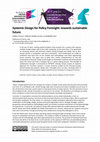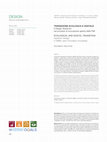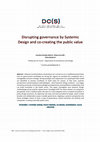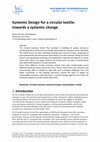Papers by Eliana Ferrulli

Business Strategy and the Environment, Dec 3, 2023
This study builds on the Circular Economy paradigm which recognises consumers as key stakeholders... more This study builds on the Circular Economy paradigm which recognises consumers as key stakeholders in extending textiles' lifespan. The paper unfolds how consumers engage in the textile disposal practices of reuse, repair, donate and resell. In doing so, consumers create a value-indisposition , here conceptualised as the enhanced value that consumers generate through the process of transforming depleted textiles into new meaningful ones. This research adopts a multimethod platform focused ethnography that combines textual, visual and audio data, generated in the domestic environment, which facilitates contextual and situational insights. The findings highlight that value-indisposition goes far beyond the utilitarian aspects (e.g. economic or functional) and includes social, aesthetic, emotional and moral value dimensions, which contribute in building an overarching environmental value. The study shows that consumer disposal practices not only reduce waste but also favour consumer empowerment through the transformation of unused/depleted resources into new value. Finally, the article provides specific managerial insights on the design of textile products and services to encourage consumer engagement in reuse, repair, donation, and resell practices, supporting companies in the Circular Economy uptake. K E Y W O R D S circular economy, consumer empowerment, platform focused ethnography, textile disposal practices, value-indisposition 1 | INTRODUCTION To keep or not to keep is a life-or-death matter when we address textiles' lifespan, and this is a question that presents a serious environmental challenge. Currently, across Europe, it is estimated that consumers dispose between 80% and 85% of their unwanted textiles between regular household waste, resulting in incineration or landfilling (EPRS, 2019). Overall, the Textile & Clothing industry, which includes both home and fashion textiles, is the fourth worstranked category for the use of primary raw materials and water-after food, housing and transport-and fifth for GHG emissions (Vercalsteren et al., 2019). To tackle these challenges, the European Union (EU) has included textiles as one of the priority sectors of the 'Circular Economy Action Plan', a roadmap of actions aiming to 'close the loop' of products' life cycles through resource-efficient processes, recycling and reuse practices. Within this strategic plan, the EU

Conference Proceedings of the Academy for Design Innovation Management, Nov 4, 2019
In the last 15 years, tackling wicked problems have evolved into a process that requires multiple... more In the last 15 years, tackling wicked problems have evolved into a process that requires multiple change-makers able to face with complexity. At the same time, it has generated an increasing interest and proficient relation among foresight and design, due to their shared interest in anticipation and future orientation. Such relationships are visible on similarities they both have on the mindset and methodology used when approaching future scenarios. This paper aims to delve into a better comprehension on how the combination of Systemic Design and foresight can think both creatively and systematically about the future and have a strategic role in a policy-making process. This example of collaborative foresight is illustrated by RETRACE Interreg Europe project (A Systemic Approach for Transition towards a Circular Economy funded by the Interreg Europe), demonstrating how Systemic Design with a foresight vision can play a leverage effect in the transition of the European regions towards Circular Economy in a long-term horizon.

AGATHÓN – International Journal of Architecture, Art and Design, 2023
A systemic and collaborative approach is required to facilitate European Small and Medium- sized ... more A systemic and collaborative approach is required to facilitate European Small and Medium- sized Enterprises’ ecological and digital transition, able to frame issues within the complexity of the relationships and interconnections that characterise them. In light of this, the paper aims to investigate how the approach and methods of Systemic Design support an ‘open innovation’ process in industrial and interdisciplinary environments. The DigiCirc European project represents the reference case study, offering a space to test the challenges found in the literature with data collected in the field, emphasising the contribution made by the researchers in Systemic Design of the Politecnico di Torino, both as project partners in the ‘open innovation’ process and through activities supporting the start-ups and SMEs involved. The article is mainly geared toward scholars and design practitioners concerned with ‘open innovation’ and ecological and digital transition within socio-technical systems and in industrial and interdisciplinary environments.

Design Culture(s). Cumulus Conference Proceedings Rome 2021, 2021
Massive transformations characterize our current era at a multidimensional level, and our governm... more Massive transformations characterize our current era at a multidimensional level, and our governments worldwide are facing the urgency to translate this complexity into a manageable common strategy. Strong synergies and cooperation on a quadruple-helix model are identified as primary conditions to build value for society. In that view, systemic perspectives and participatory methodologies-which Systemic Design combines-can trigger innovative processes of sharing knowledge and experiences among different stakeholders and can build innovation in the public sector. This paper investigates how Systemic Design methodology can be used for a governance "paradigm shift" for value creation, on a long term perspective. Such a method opens the way to a more adaptive and co-creative innovation in policy-design processes, by exploring new ways and tools provided by design, which enable broader and collaborative access to public governance. Applying a systemic perspective into those strategies means to favor a type of governance, whose outcomes are iterative and autopoietic, creating endurable public value.

Blucher Design Proceedings
The Circular Economy Action Plan provides a roadmap of actions aiming at accelerating the transfo... more The Circular Economy Action Plan provides a roadmap of actions aiming at accelerating the transformational change required by the European Green New Deal. The textile sector has been identified amongst the industrial sectors recognized of great potential for the reconversion from linear to circular economy. Being one of the world's most globalized, polluting, and exploitative industries throughout its whole value chain, there is an urgent need for the textile sector to make a transformative and radical shift towards a Circular Economy. Since 2015, different Circular Economy actions have been implemented across different industrial sectors and at the micro / meso / macro level, but a systemic and cross-sectoral effort is needed to cope with such a complex challenge. Thus, this paper contributes to the ongoing discussion around the topic of design for sustainability aiming to understand how a systemic design approach can foster the transition towards a circular textile value chain.








Uploads
Papers by Eliana Ferrulli